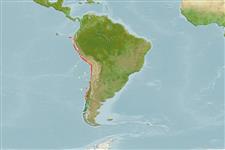>
Gadiformes (Cods) >
Macrouridae (Grenadiers or rattails)
Etymology: Coryphaenoides: Greek, koryphaina = dolphin fish + Suffix oides = similar to (Ref. 45335).
More on authors: Gilbert & Thompson.
Environment: milieu / climate zone / depth range / distribution range
Ecología
marino batidemersal; no migratorio; rango de profundidad 768 - 1860 m (Ref. 1371). Deep-water; 2°S - 40°S, 85°W - 70°W (Ref. 1371)
Southeast Pacific: northern Peru to southern Chile. Also Eastern Central Pacific (Ref. 9315).
Tamaño / Peso / Age
Maturity: Lm ? range ? - ? cm
Max length : 46.0 cm TL macho / no sexado; (Ref. 1371)
Espinas dorsales (total) : 2; Espinas anales: 0. Eyes large, its diameter 25 to 36 percent of head length; snout short, moderately pointed, its underside and leading edge naked except for scutes at the tip and lateral angles; chin with very small barbel. Scales on body with spinules (conical in young, more triangular and flattened in adults) arranged in divergent longitudinal rows. Overall color is light to medium brown; lips and barbel dark brown; oral cavity blackish.
Life cycle and mating behavior
Maturities | Reproducción | Spawnings | Egg(s) | Fecundities | Larva
Cohen, D.M., T. Inada, T. Iwamoto and N. Scialabba, 1990. FAO species catalogue. Vol. 10. Gadiform fishes of the world (Order Gadiformes). An annotated and illustrated catalogue of cods, hakes, grenadiers and other gadiform fishes known to date. FAO Fish. Synop. 125(10). Rome: FAO. 442 p. (Ref. 1371)
IUCN Red List Status (Ref. 130435)
Threat to humans
Harmless
Human uses
Pesquerías: pesquerías de subsistencia
Herramientas
Special reports
Download XML
Fuentes de Internet
Estimates based on models
Preferred temperature (Ref.
123201): 3.3 - 4.5, mean 3.9 °C (based on 11 cells).
Phylogenetic diversity index (Ref.
82804): PD
50 = 0.5000 [Uniqueness, from 0.5 = low to 2.0 = high].
Bayesian length-weight: a=0.00219 (0.00111 - 0.00431), b=3.20 (3.03 - 3.37), in cm total length, based on LWR estimates for this (Sub)family-body shape (Ref.
93245).
Nivel trófico (Ref.
69278): 3.5 ±0.4 se; based on size and trophs of closest relatives
Resiliencia (Ref.
120179): Bajo, población duplicada en un tiempo mínimo de 4.5-14 años (Preliminary K or Fecundity.).
Fishing Vulnerability (Ref.
59153): Moderate vulnerability (36 of 100).
